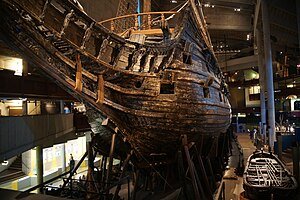1961 Salvage of the Vasa: A Remarkable Feat of Marine Archaeology
On April 24, 1961, a significant event took place in the history of maritime archaeology and engineering. The Swedish warship Vasa, which had sunk on its maiden voyage in 1628, was successfully salvaged from the Stockholm harbor. This 17th-century ship, intended to be a symbol of Sweden’s naval power, tragically sank due to design flaws after sailing less than a nautical mile. The salvage of the Vasa in 1961 remains a remarkable achievement that provides valuable insights into maritime history, 17th-century artisanship, and naval warfare.
The Tragic Story of the Vasa
The Vasa was commissioned by King Gustavus Adolphus of Sweden and was built to be the most powerful warship of its time. It was lavishly decorated and adorned with intricate sculptures, making it a true masterpiece of craftsmanship. However, the ship’s design proved to be its downfall.
On August 10, 1628, the Vasa set sail for its maiden voyage with great fanfare. As it sailed just a short distance, a gust of wind caused the ship to list heavily to one side. Water rushed into the open gunports, and within minutes, the Vasa sank to the bottom of the harbor. The exact cause of the sinking was later determined to be a combination of factors, including the ship’s top-heavy design, insufficient ballast, and inadequate stability.
A Long-Lost Ship Rediscovered
For over three centuries, the Vasa lay forgotten at the bottom of the Stockholm harbor. However, in the early 1950s, Swedish marine archaeologist Anders Franzén discovered the ship’s location using old maps and historical records. His findings sparked a renewed interest in salvaging the Vasa and preserving it as a historical artifact.
After years of planning and preparation, the salvage operation began in 1959. Engineers constructed a massive steel frame around the ship and used cables and pontoons to raise it from the seabed. On April 24, 1961, the Vasa finally emerged from the water, marking a momentous occasion in the field of marine archaeology.
The Preservation and Restoration of the Vasa
Following its recovery, the Vasa underwent an extensive preservation and restoration process. The ship was sprayed with a mixture of polyethylene glycol and water to replace the waterlogged wood with a stabilizing substance. This process took several years to complete and required careful monitoring to ensure the ship’s structural integrity.
Today, the Vasa Museum in Stockholm proudly showcases the well-preserved warship. Visitors can marvel at the intricate carvings, explore the various decks, and learn about the lives of the sailors who once served on board. The museum also provides valuable insights into 17th-century artisanship, naval warfare, and the historical context in which the Vasa was built.
A Symbol of Sweden’s Maritime History
The Vasa has become an iconic symbol of Sweden’s maritime history and a testament to the country’s naval ambitions during the 17th century. Its recovery and subsequent preservation serve as a reminder of the importance of learning from past mistakes and the value of preserving historical artifacts for future generations.
The salvage of the Vasa in 1961 was not only a significant event in Swedish history but also a groundbreaking achievement in the field of marine archaeology. Through meticulous planning, engineering expertise, and the dedication of countless individuals, the Vasa was brought back to the surface after centuries of obscurity. Today, visitors from around the world can witness the grandeur of this 17th-century warship and gain a deeper understanding of the maritime history it represents.
For more information about the Vasa and its salvage, you can visit the official Vasa Museum website.

